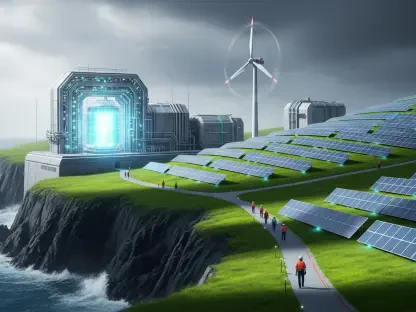Wales finds itself at a pivotal moment in the global push for clean energy investment, grappling with an electricity grid that’s buckling under the weight of modern demands. As industries pivot to electrification, green hydrogen projects gain traction, and electric vehicle infrastructure expands rapidly, the region’s outdated transmission network—especially in South Wales—poses a severe bottleneck. This isn’t merely a technical hiccup; it’s a potential economic disaster that could derail billions in prospective projects. Delving into this pressing issue, the discussion centers on whether Wales can overcome these infrastructure challenges or risk losing ground to regions better equipped for the energy transition. The stakes are enormous, with gridlock delaying critical initiatives by up to a decade, shaking investor confidence, and threatening local job markets. With capital and talent free to move elsewhere, the urgency for actionable solutions has never been clearer.
Gridlock: The Core Challenge
Rising Demand and Failing Infrastructure
The electricity grid in Wales, particularly in the southern region, is facing an unprecedented strain due to a dramatic surge in demand from multiple sectors. Industrial electrification, the rise of green hydrogen production, and the expansion of electric vehicle charging networks are pushing the system to its limits. South Wales, once a net exporter of power, has shifted to importing electricity, relying on a grid constructed through decades of incremental, reactive planning. This outdated framework is woefully unprepared for the scale of today’s energy transition goals. The mismatch between soaring needs and stagnant capacity isn’t just a logistical issue—it’s a fundamental barrier to progress. Without significant upgrades, the region struggles to support the infrastructure necessary for a sustainable future, leaving ambitious projects in limbo and raising concerns about long-term viability in a competitive global landscape.
Compounding the problem is the historical lack of foresight in grid development, which has failed to anticipate the rapid pace of technological and industrial change. The current infrastructure, pieced together over generations, lacks the robustness to handle the simultaneous demands of modern industries and emerging technologies. For instance, the integration of renewable energy sources, critical to decarbonization efforts, requires a grid capable of managing fluctuating inputs, yet Wales’s system often falters under this pressure. This inadequacy not only hampers immediate project timelines but also casts doubt on the region’s ability to adapt to future innovations. As other areas invest in scalable solutions, the gap widens, positioning Wales at a disadvantage in attracting the partnerships and funding needed to drive the energy shift forward. The need for a comprehensive overhaul is evident, lest the region fall further behind.
Investment Delays and Economic Fallout
Gridlock is directly strangling major investment projects across Wales, with connection delays stretching timelines by as much as ten years, creating significant obstacles for progress. For key stakeholders like RWE, who have committed hundreds of millions to the region’s energy future, these setbacks disrupt not just individual initiatives but entire economic ecosystems. Supply chains falter as procurement stalls, local employment opportunities diminish, and the financial viability of projects comes under threat. Investor confidence, already fragile in an uncertain global market, takes a severe hit when timelines become unpredictable. The ripple effects extend beyond immediate stakeholders, impacting communities reliant on the jobs and growth these investments promise. If unresolved, this grid bottleneck risks turning Wales into a less attractive destination for capital in a fiercely competitive arena.
Moreover, the broader economic implications of these delays are stark, threatening to undermine Wales’s role in the UK’s industrial strategy, and as capital proves mobile, investors may redirect funds to regions or countries with more reliable infrastructure, leaving Wales to grapple with missed opportunities. The loss of high-skilled jobs and the stunting of regional development are real possibilities if grid issues persist. Beyond immediate financial losses, there’s a strategic cost—failing to keep pace with the energy transition could diminish the region’s relevance in national decarbonization efforts. This isn’t merely about delayed projects; it’s about the potential erosion of economic competitiveness. Addressing grid capacity must become a priority to safeguard both current investments and future prospects, ensuring that Wales remains a viable player in the clean energy landscape.
Competing Priorities on the Grid
Data Centers Draining Capacity
Along the M4 corridor in South Wales, the explosive growth of data centers is placing immense pressure on an already strained electricity grid, consuming hundreds of megawatts of capacity. These facilities, integral to the UK’s industrial and digital strategy, offer substantial commercial returns and are deemed critical infrastructure. However, their voracious energy demands often come at the expense of other vital sectors, including clean energy initiatives. A striking example involves RWE’s attempt to establish a microgrid for a significant energy project, only to be thwarted by a lack of available capacity until 2034. This clash illustrates the severity of the competition for grid resources, where the unchecked expansion of data centers risks sidelining projects that could drive long-term sustainability. The situation demands urgent attention to prevent a lopsided allocation that could hinder broader industrial goals.
The dominance of data centers in grid consumption raises important questions about equity in resource distribution across industries. While their economic contributions are undeniable, allowing these facilities to monopolize capacity could deprive other sectors of the power needed to innovate and grow. Clean energy projects, essential for meeting decarbonization targets, often find themselves deprioritized, despite their potential to deliver widespread environmental benefits. This imbalance threatens to create a narrow industrial focus, where short-term financial gains overshadow strategic imperatives for a balanced energy future. Policymakers face the complex task of managing this tension, ensuring that data centers coexist with other priorities rather than overwhelm them. Without intervention, Wales risks becoming a hub for digital infrastructure at the cost of its renewable energy ambitions, a trade-off that could prove costly in the long run.
Balancing Act for Strategic Growth
Navigating the competing demands on Wales’s grid requires a delicate balancing act to foster strategic growth across diverse sectors, ensuring that no single industry dominates to the detriment of others. Data centers, while economically lucrative, cannot be allowed to monopolize capacity at the expense of clean energy and industrial electrification projects. A lack of oversight in allocation risks locking out initiatives that are critical to long-term sustainability and regional competitiveness. For instance, green hydrogen production and battery storage facilities, both pivotal to the energy transition, struggle to secure the power they need when capacity is disproportionately consumed elsewhere. Establishing a framework to prioritize a diverse energy mix is essential to maintain Wales’s appeal to a broad range of investors. This approach must weigh immediate economic benefits against the enduring value of a sustainable industrial base, ensuring no single sector overshadows others.
Furthermore, strategic planning must extend beyond mere allocation to encompass proactive investment in grid expansion tailored to multiple needs. Government and industry collaboration is vital to identify and support shovel-ready projects that align with national decarbonization goals while accommodating digital infrastructure growth. This involves not only technical upgrades but also policy mechanisms to guide resource distribution equitably. Public understanding of these competing priorities remains limited, often leading to resistance against necessary infrastructure developments. Transparent communication about the benefits of a balanced approach, coupled with tangible action, can help build support for the tough decisions ahead. If Wales is to secure its place in the global energy race, a holistic strategy that embraces diversity in industrial development must take root, preventing any one sector from derailing the broader vision for progress.
Policy and Planning Barriers
Outdated Approaches and Costly Preferences
For decades, grid planning in Wales has followed a reactive, incremental path, ill-suited to the rapid electrification and industrial shifts of the present day, leaving the region’s infrastructure scrambling to meet current demands. This outdated methodology has made it difficult to prepare for future growth. Compounding the issue is a political preference for undergrounding electrical infrastructure to avoid the visual impact of pylons, despite costs that can be up to five times higher than overhead lines. While aesthetically appealing, this approach significantly inflates expenses, often passing the burden onto consumers through higher energy bills. Such costly decisions also risk deterring investors who seek cost-effective environments for their projects. The disconnect between historical planning habits and today’s urgent needs underscores a critical flaw in the system, one that must be addressed to align with the pace of the energy transition.
Additionally, the insistence on undergrounding reflects a broader challenge of balancing public sentiment with pragmatic infrastructure development, a critical issue in modern planning. Limited awareness among communities about the financial and strategic trade-offs fuels resistance to more affordable alternatives like overhead transmission lines. This lack of understanding can stall essential projects, further exacerbating gridlock and delaying the integration of renewable energy sources. Investors, already wary of extended timelines, may view these politically driven choices as additional hurdles, potentially redirecting capital to regions with more streamlined policies. To counter this, a shift toward evidence-based planning is necessary, prioritizing efficiency and scalability over short-term visual concerns. Only by rethinking these entrenched approaches can Wales hope to build a grid capable of supporting its ambitious industrial and environmental goals without alienating the funding needed to achieve them.
Lack of Cohesive Strategy
In the absence of a unified, Wales-wide energy strategy, there exists a significant barrier to overcoming grid challenges and securing investment, which is critical for sustainable development. Unlike a coordinated plan that aligns with UK national priorities, the current fragmented approach fails to address capacity as a strategic imperative. This gap leaves critical decisions disjointed, with local policies often clashing with broader energy transition objectives. Public awareness of the stakes—such as the economic fallout from delayed projects or the benefits of robust infrastructure—remains low, hindering support for necessary reforms. Without a clear framework to guide development, Wales struggles to present itself as a reliable destination for clean energy funding. Establishing national planning policies that explicitly prioritize grid capacity could bridge this divide, ensuring that all stakeholders work toward a common goal of sustainable growth and competitiveness.
Moreover, the lack of strategic cohesion extends to how competing industrial demands are managed, often resulting in ad-hoc solutions that fail to address root causes. For instance, the tension between data centers and renewable energy projects highlights the need for a deliberate policy to balance these interests, yet no such mechanism exists at a regional level. This inconsistency not only slows progress but also erodes trust among investors who require predictability to commit long-term resources. A Wales-specific strategy, integrated with UK-wide energy goals, must emerge to streamline decision-making and allocate resources effectively. Transparent dialogue with communities about the real costs of inaction—both economic and environmental—could further galvanize support for bold action. Until such a cohesive plan takes shape, the region risks remaining mired in inefficiencies, unable to capitalize on the global wave of clean energy investment.
Government and Industry Response
National Grid and UK Initiatives Under Strain
National Grid faces an enormous challenge in delivering what many describe as the most significant infrastructure overhaul in generations, tasked with modernizing a system that has lagged behind industrial evolution. At the same time, the UK Government has introduced measures like the National Energy System Operator (NESO), Grid Reform, and the Connections Accelerator to prioritize shovel-ready projects and streamline grid access. These initiatives aim to take a more strategic view of energy needs, cutting through bureaucratic delays that have historically hampered progress. However, despite these efforts, the scale of the crisis in Wales often outstrips the resources and timelines allocated. Without substantial funding and a laser focus on capacity expansion, these programs struggle to deliver the transformative change needed to keep pace with surging demand. The pressure on both National Grid and governmental bodies to adapt swiftly is palpable, as delays continue to mount.
Critics argue that while these UK-wide initiatives are a step in the right direction, they lack the specificity to address Wales’s unique bottlenecks, particularly in areas like Mid-Wales where transmission links are notoriously constrained, adding to the region’s energy challenges. The complexity of upgrading an aging grid while integrating new technologies—such as renewable energy sources and smart systems—adds layers of difficulty to an already daunting task. National Grid’s efforts are further complicated by the need to balance competing regional demands across the UK, often leaving Wales’s needs deprioritized. Meanwhile, government programs, though well-intentioned, face criticism for insufficient investment to match the urgency of the situation. For these measures to succeed, a tailored approach that accounts for regional disparities and accelerates funding for critical upgrades must be adopted. Until then, the strain on existing systems threatens to undermine even the most ambitious policy goals.
Call for Stronger Oversight and Action
Stakeholders across the energy sector are pressing for enhanced government intervention to manage the intricate balance of infrastructure needs spanning electricity, hydrogen, and data centers. A key demand is for clearer oversight to ensure that grid capacity is allocated in a way that supports a diverse industrial base rather than favoring one sector over others. This involves not only technical solutions but also strategic policymaking to guide long-term development. Equally important is the role of public communication—articulating the tangible benefits of grid investment, such as job creation and lower carbon emissions, alongside the stark consequences of delay, can help build broader support for essential upgrades. Without this dual focus on policy and engagement, resistance to infrastructure projects may persist, further slowing progress at a time when speed is critical to maintaining competitiveness.
Beyond oversight, there’s a growing consensus that actionable steps must be taken to address specific regional challenges, such as the transmission bottlenecks in Mid-Wales. Accelerated upgrades in these areas could unlock significant energy potential, making Wales a more attractive hub for investment. Advocacy for a pragmatic stance on infrastructure—limiting costly undergrounding to high-value scenic areas while prioritizing efficiency elsewhere—also gains traction as a way to manage costs and timelines. Government bodies are encouraged to align Wales-specific strategies with national energy mix goals, ensuring a unified push toward decarbonization. By fostering collaboration between industry leaders and policymakers, and by investing in public education about the stakes involved, a path forward can be charted. Only through such concerted, immediate action can the region hope to secure its place in the rapidly evolving landscape of clean energy innovation.
Securing a Sustainable Future
Reflecting on the challenges faced, it became evident that gridlock in Wales had posed a formidable barrier to economic and environmental progress, with delays in major investments driven by outdated infrastructure stifling job creation and shaking investor trust at a critical juncture. The unchecked growth of data centers had further complicated matters, often overshadowing the needs of clean energy projects essential for decarbonization. Historical planning missteps and costly political preferences had only deepened the crisis, while government initiatives, though promising, had struggled to match the urgency of the situation. Moving forward, a focused strategy emerged as the linchpin for change. Prioritizing grid capacity as a national imperative, accelerating targeted upgrades in bottlenecked areas, and fostering public support through clear communication were identified as vital next steps. By embracing a balanced approach to industrial demands and aligning regional plans with UK goals, Wales could still carve out a leadership role in the energy transition, ensuring that past setbacks paved the way for a resilient, sustainable future.









